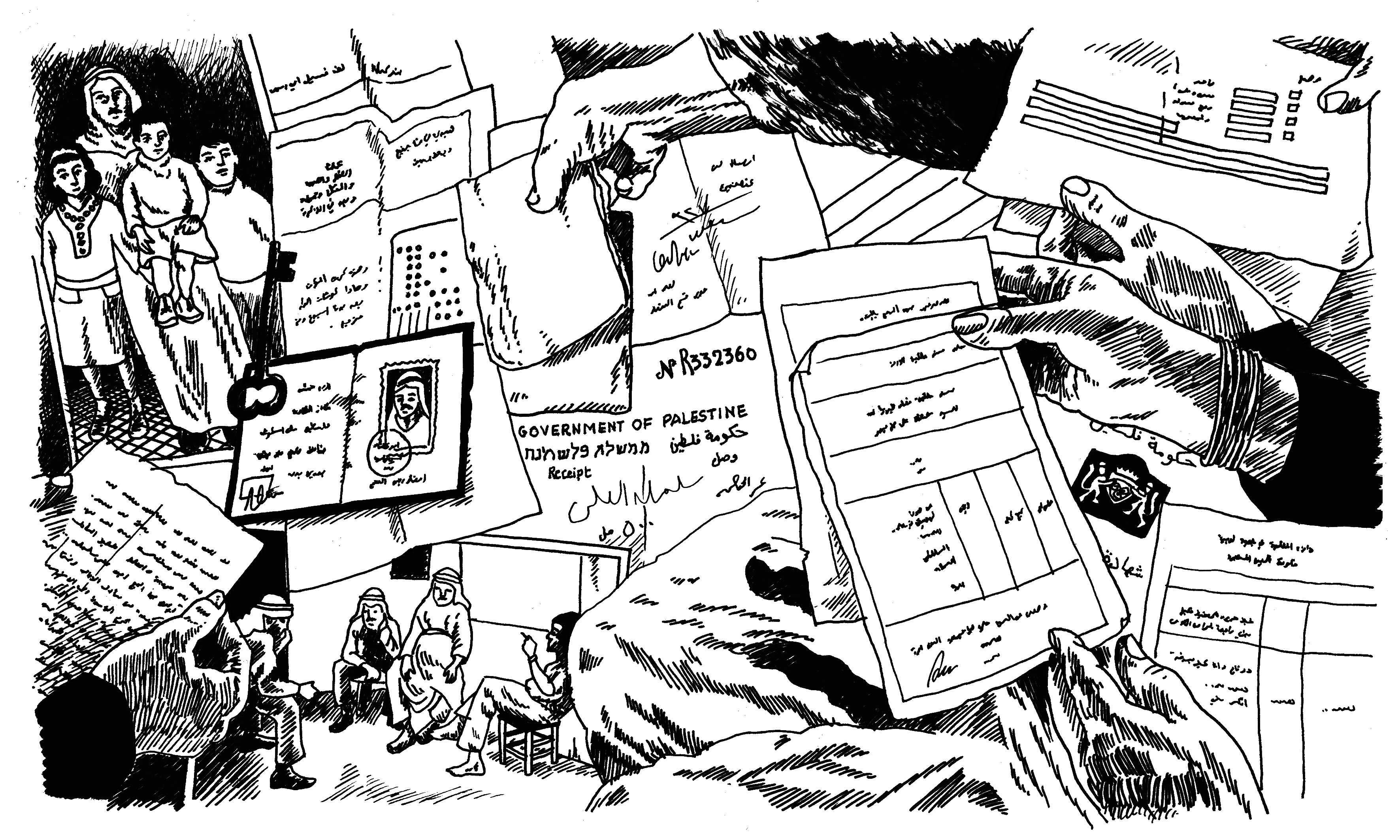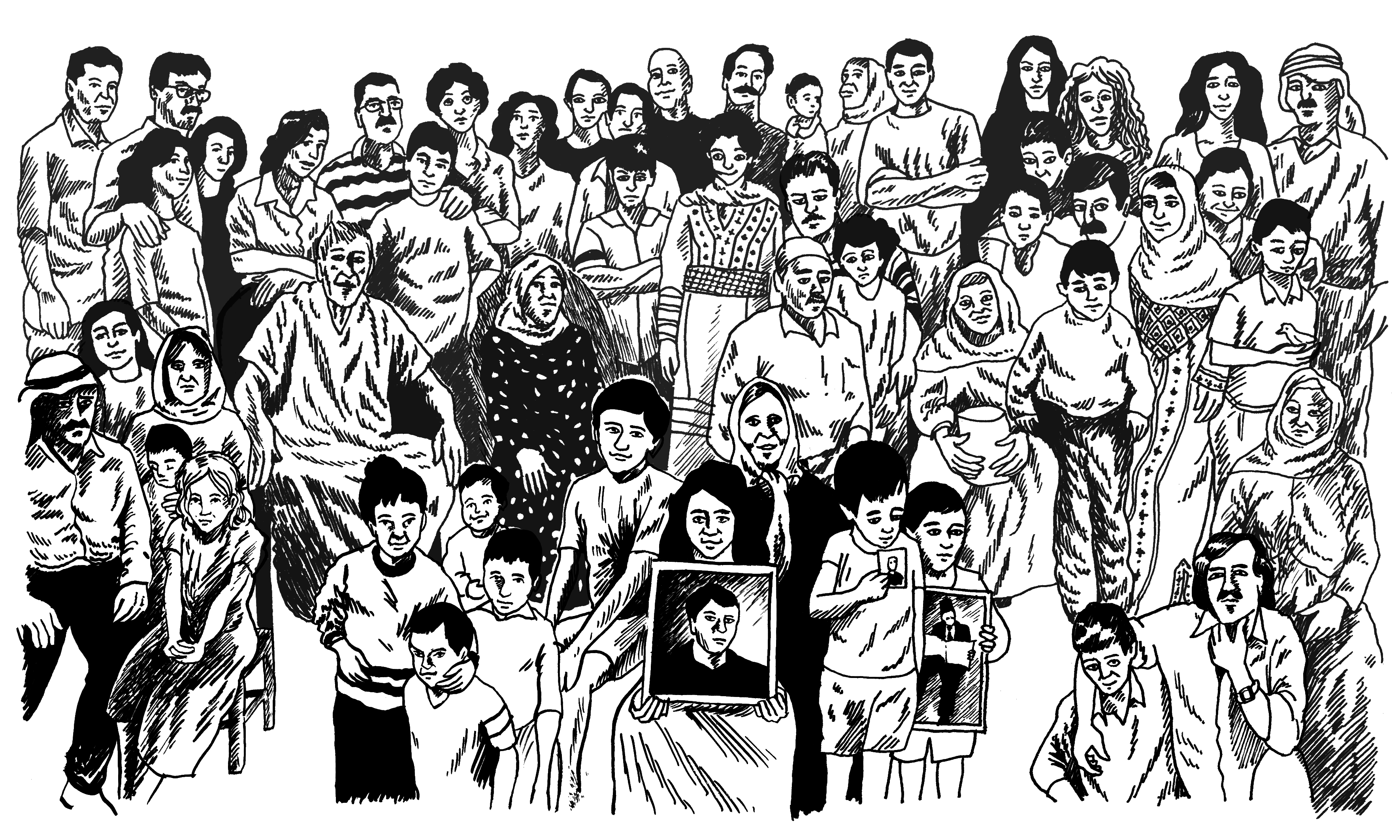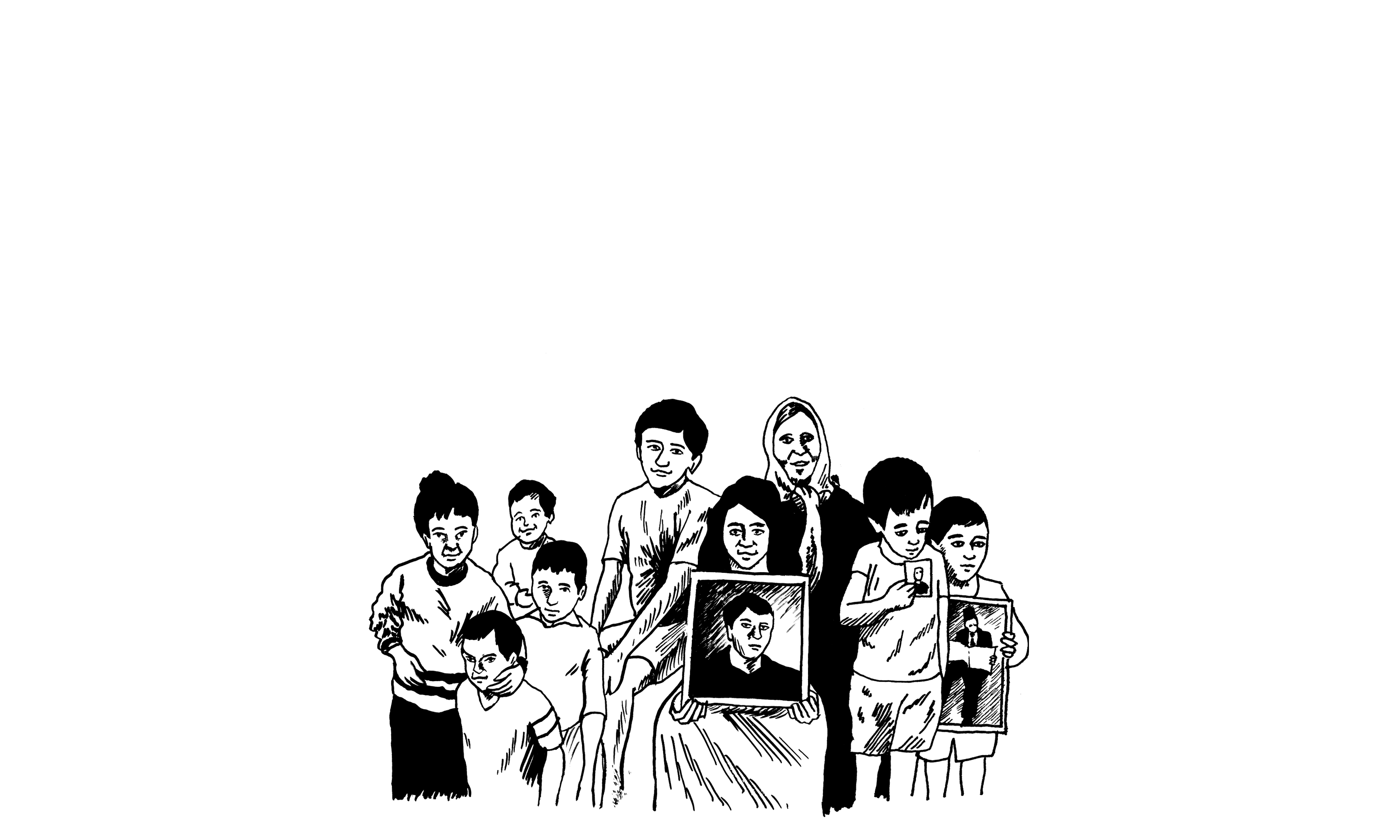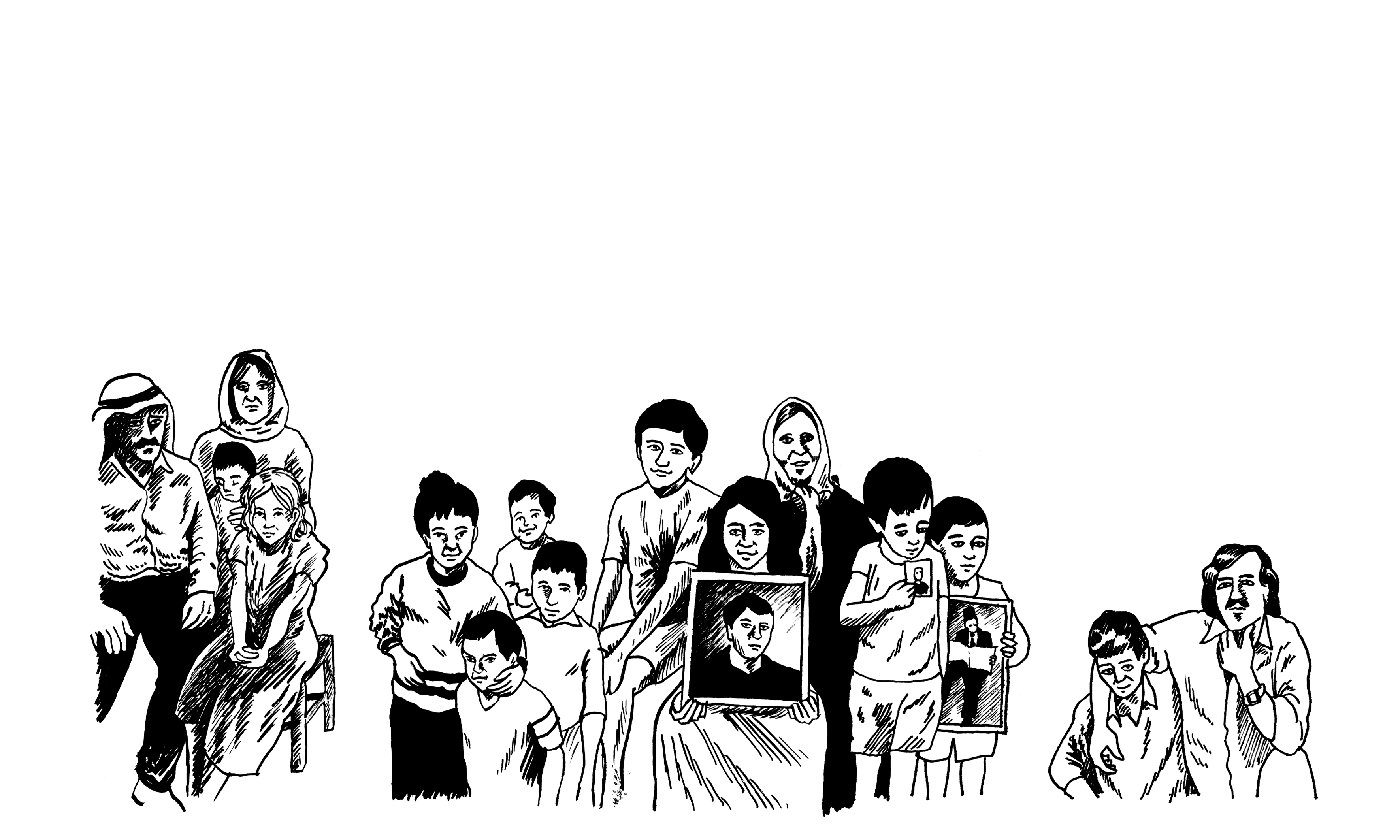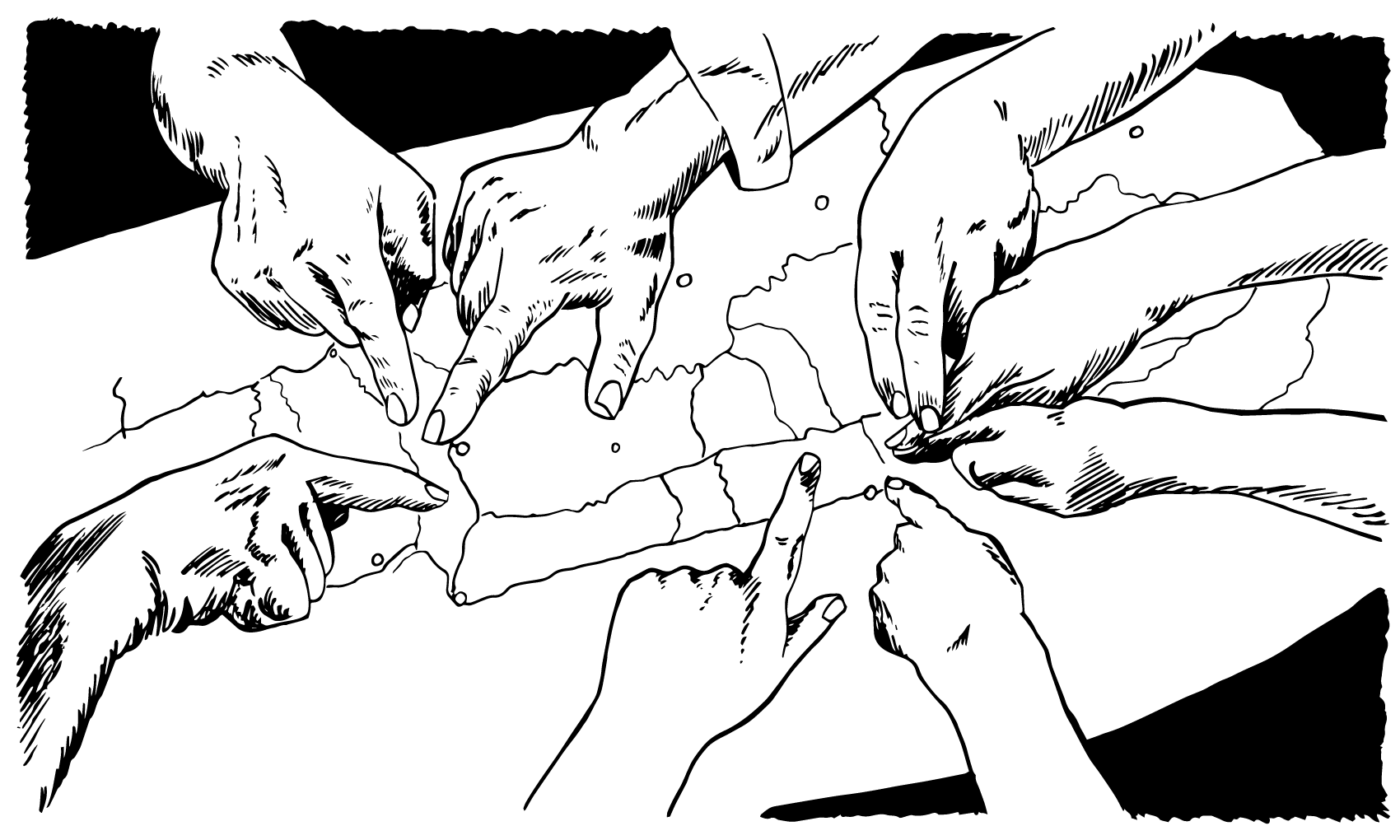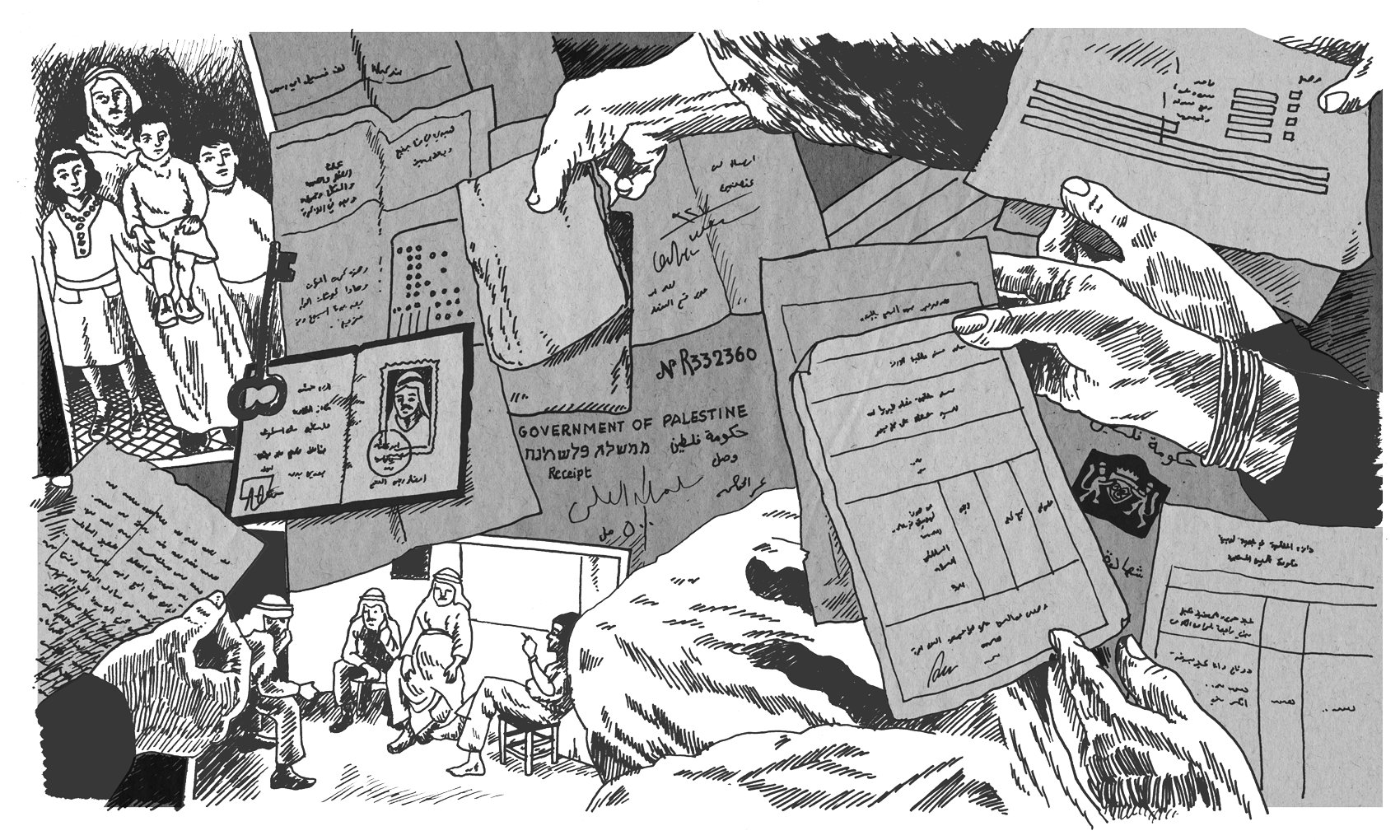Recorded by refugees from the camps in Lebanon, these narratives bring us closer to life in pre-1948 Palestine and the foundational experience of dispossession. They illuminate the meaning of this collective tragedy and help us understand how the Nakba has impacted Palestinian lives across generations, and the formation of collective consciousness in the ongoing struggle for liberation, self-determination and return. The interviews are available in Arabic via the Palestinian Oral History Archive (POHA) Library database.
This virtual collection is conceived as a living archive that offers a dynamic, evolving platform for critical and creative engagement with this vital heritage. In addition to adding subtitled video interviews in English, we are developing interactive learning resources and creative projects that extend and respond to our growing collection in a variety of media. In this spirit, we commissioned Barrack Rima’s wonderful illustrations for the homepage, along with other works.
We invite community members, organizers, artists, scholars and educators to join us and participate in bringing this collaborative digital space to life. Your contributions are welcome.
وهذه الروايات التي سجلها لاجئون من المخيمات الفلسطينية في لبنان، تقربنا أكثر من الحياة في فلسطين قبل العام 1948، ومن تجربة الطرد ونزع الملكية المؤسسة لدولة اسرائيل. كما توضح هذه المقابلات معنى هذه المأساة الجماعية، وتساعدنا في فهم كيف أثرت النكبة على حياة الفلسطينيين عبر الأجيال، وكيف أثرت على تشكيل الوعي الجماعي في النضال المستمر من أجل التحرير، وتقرير المصير، والعودة. أخيرا هذه المقابلات متوفرة باللغة العربية من خلال بيانات مكتبة أرشيف التاريخ الشفوي الفلسطيني (POHA) في الجامعة الاميركية في بيروت. كما تعتبر هذه المجموعة الافتراضية أرشيفا حيا يوفر منصة دينامية ومتطورة للمشاركة النقدية والابداعية مع هذا التراث الحيوي.
لقد قمنا بترجمة بعض المقابلات الى اللغة الانكليزية. كما اننا نقوم بتطوير موارد تعلمية / تعليمية تفاعلية ومشاريع أبداعية توسع وتستجيب لمجموعتنا المتنامية بوسائط متنوعة. وبهذه الروح، كلفنا باراك ريما بانتاج الرسومات التوضيحية الرائعة للصفحة الرئيسية اضافة الى أعمال أخرى. ندعوا أعضاء المجتمع، ومنظمي النشاطات، والفنانين، والأكادميين، والمعلمين للانضمام الينا والمشاركة في احياء هذه المساحة الرقمية. ونرحب بمساهماتكم.
Living Archives
Forms of Presence • Sound workshop • Nakba stories • Partition
The Nakba Archive is committed to supporting grassroots historical knowledge production, by and for Palestinian communities living in Lebanon. We approach history as a multifaceted collective process, and this collection as an evolving, living archive. In developing new documentary projects, we encourage creative responses to the archive in any media, with a view to diversifying access to historical knowledge and engaging wide-ranging audiences.The projects hosted here draw on longstanding local partnerships with Palestinian schools and community organizations. They are designed and implemented in close collaboration with participants and local communities, with a view to building sustainable, refugee-led resource bases to advance research, teaching and learning capacities. The Nakba Archive collective has provided facilitation, training and equipment to support local creative projects and ongoing initiatives to document and disseminate histories of internal displacement in Lebanon. This work has been funded by the Local Engagement Refugee Research Network and the Social Sciences and Humanities Research Council.
أرشيفات حية
أشكال الوجود • ورشة الصوت • قصص النكبة • تقسيم
فنحن نتعامل مع التاريخ كعملية جماعية ذات أوجه متعددة، وهذه المجموعة كأرشيف حي ومتطور. ومن هنا ونحن بصدد تطوير مشاريع وثائقية جديدة، فاننا نشجع الاستجابات الابداعية للأرشيف بمختلف الوسائط بهدف تنويع الحصول على المعرفة التاريخية وأشراك جماهير واسعة النطاق. تستند المشاريع التي يتم استضافتها هنا الى شراكات محلية طويلة الأمد مع مدارس ومنظمات مجتمعية فلسطينية. وقد تم تصميمها وتنفيذها بالتعاون الوثيق مع مشاركين، ومجموعات محلية بهدف بناء موارد مستدامة يديرها اللاجئون لتعزيز قدرات البحث والتعليم والتعلم لديهم. قدم أرشيف النكبة التسهيلات، والتدريب والمعدات لدعم المشاريع الابداعية المحلية والمبادرات مستمرة لتوثيق ونشر تواريخ النزوح الداخلي في لبنان. وقد تم تمويل هذا العمل من قبل شبكة أبحاث اللاجئين للمشاركة المحلية ومجلس أبحاث العلوم الاجتماعية والانسانية
Forms of Presence
How can an archive account for the diverse forms of Palestinian refugee presence in Lebanon? Building on and expanding the Nakba Archive’s original collection of oral history interviews, Forms of Presence is a collaborative attempt to curate an archive that explores secondary displacement within Lebanon and underlines the entwinement of Palestinian dispersal and presence both inside and outside formal refugee camps. Focusing on everyday life in Wavel refugee camp in East Bekaa and in the town of Bar Elias in Central Bekaa where Palestinians live and work in their own communities known as tajamo’ or “informal gatherings”, Forms of Presence is an inquiry into the sociohistorical and environmental conditions that spawned other forms of Palestinian encampment — including the disappeared camp communities of 1950s Lebanon. It is also a project that seeks to draw connections between these historical events and larger structural forces on one hand, and the intimacies of situated embodied experience on the other.The audio-records which will be published here are vivid historical portraits of the early years of Palestinian presence in the Bekaa Valley of Lebanon. From these accounts, Palestinian presence in Lebanon emerges not simply as ‘protracted’, ‘temporary’ or ‘transient’, but rather as a form of lingering peril characterized by displacement and entanglement with war, resistance and liberation struggles, as well as the lived experience of exile.
Forms of Presence was developed with assistance from Mahmoud Samih Al-Ahmad (researcher).
النص قيد الترجمة
أشكال الوجود
Audio-recorded interviews
Ahmad Abdel Hadi Al Ayna
born 1946 in Alma, Palestine
Interviewer: Mahmoud Al-Ahmad
Interview location: Bar Elias, Lebanon
Interview date: 31-Oct-21
أحمد عبد الهادي العينا
مواليد 1946 في علما قضاء صفد فلسطين
المحاور: محمود الأحمد
موقع المقابلة: بر الياس ، لبنان
تاريخ المقابلة: 31-10-21
Mariam Hassan Moussa
born 1936 in Mghar Al Khayt, Palestine
Interviewer: Mahmoud Al-Ahmad
Interview location: Bar Elias, Lebanon
Interview date: 31-Oct-2021
مريم حسن موسى
مواليد 1936 في مغار الخيط قضاء صفد، فلسطين
المحاور: محمود الأحمد
موقع المقابلة: بر الياس ، لبنان
تاريخ المقابلة: 31-10-2021
Omar Awad Othman
born 1948 in Bint Jbeil, Lebanon
Interviewer: Mahmoud Al-Ahmad
Interview location: Anjar, Lebanon
Interview date: 02-Nov-2021
عمر عوض عثمان
مواليد 1948 في بنت جبيل، لبنان
المحاور: محمود الأحمد
موقع المقابلة: عنجر، لبنان
تاريخ المقابلة:02-11-2021
Khadijeh Ahmad El Hajj
born 1945 in Mghar Al Khayt, Palestine
Interviewer: Mahmoud Al-Ahmad
Interview location: Bar Elias, Lebanon
Interview date: 02-Nov-2021
خديجة أحمد الحاج
مواليد 1945 في مغار الخيط قضاء صفد، فلسطين
المحاور: محمود الأحمد
موقع المقابلة: بر الياس ، لبنان
تاريخ المقابلة:02-11-2021
Zahra Mohammad Ali Al Ayna
born 1932 in Alma, Palestine
Interviewer: Mahmoud Al-Ahmad
Interview location: Bar Elias, Lebanon
Interview date: 05-Nov-2021
زهرة محمد علي العينا
مواليد 1932 في علما قضاء صفد، فلسطين
المحاور: محمود الأحمد
موقع المقابلة: بر الياس ، لبنان
تاريخ المقابلة:05-11-2021
Amina Mahmoud Omar
born 1942 in Mghar Al Khayt, Palestine
Interviewer: Mahmoud Al-Ahmad
Interview location: Bar Elias, Lebanon
Interview date: 05-Nov-2021
آمنة محمود عمر
مواليد 1942 في مغار الخيط قضاء صفد، فلسطين
المحاور: محمود الأحمد
موقع المقابلة: بر الياس ، لبنان
تاريخ المقابلة:05-11-2021
Fatmeh Ahmad Hassan
born 1938 in Alma, Palestine
Interviewer: Mahmoud Al-Ahmad
Interview location: Bar Elias, Lebanon
Interview date: 05-Nov-2021
فاطمة احمد حسن
مواليد 1938 في مغارعلما قضاء صفد، فلسطين
المحاور: محمود الأحمد
موقع المقابلة: بر الياس ، لبنان
تاريخ المقابلة:05-11-2021
Mohammad Ahmad Abdel Ghani
born 1935 in Mghar Al Khayt, Palestine
Interviewer: Mahmoud Al-Ahmad
Interview location: Bar Elias, Lebanon
Interview date: 05-Nov-2021
محمد أحمد عبدالغني
مواليد 1935 في مغار الخيط قضاء صفد، فلسطين
المحاور: محمود الأحمد
موقع المقابلة: بر الياس ، لبنان
تاريخ المقابلة:05-11-2021
Momentum
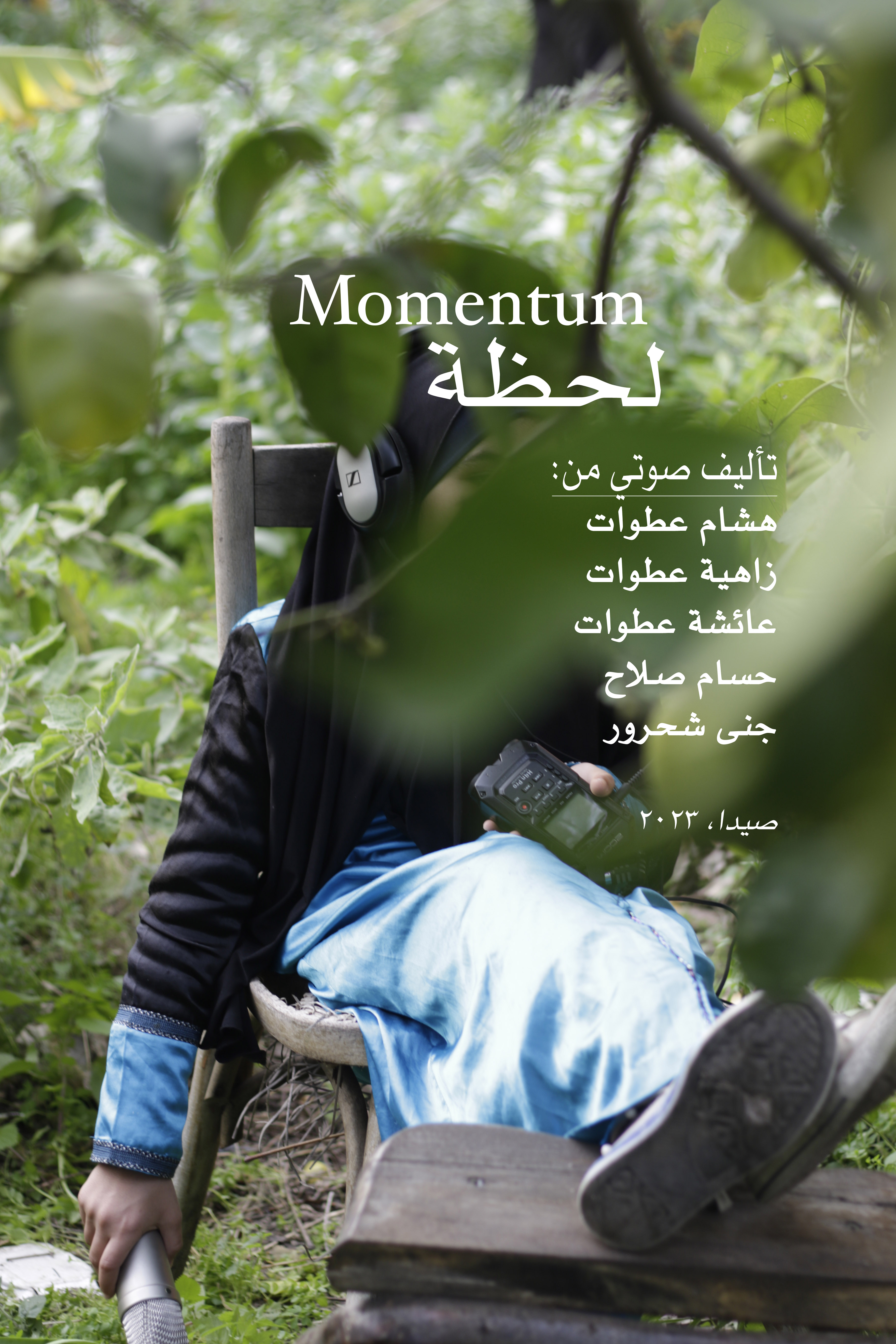
لحظة
Documentary audio piece, 2min20, stereo
Workshop participants and co-creators of Momentum Co-directors, sound recordists and sound editors:
Hisham Atwat • هشام عطوات
Zahiyah Atwat • زاهية عطوات
Aisha Atwat • عائشة عطوات
Hussam Salah • حسام صلاح
Jenna Shahrour • جنى شحرور
Workshop facilitator: Hisham Merhi
Co-facilitator: Ariane Lorrain
Location: Sikka Cultural Center, Saida, Lebanon
Date: 2023
Maps • Teaching Modules • Useful Links • Bibliography
The Nakba Archive is committed to supporting grassroots historical knowledge production, by and for Palestinian communities living in Lebanon. We approach history as a multifaceted collective process, and this collection as an evolving, living archive. In developing new documentary projects, we encourage creative responses to the archive in any media, with a view to diversifying access to historical knowledge and engaging wide-ranging audiences.The projects hosted here draw on longstanding local partnerships with Palestinian schools and community organizations. They are designed and implemented in close collaboration with participants and local communities, with a view to building sustainable, refugee-led resource bases to advance research, teaching and learning capacities. The Nakba Archive collective has provided facilitation, training and equipment to support local creative projects and ongoing initiatives to document and disseminate histories of internal displacement in Lebanon. This work has been funded by the Local Engagement Refugee Research Network and the Social Sciences and Humanities Research Council.
خرائط• مواد تعليمية • روابط مفيدة • ببليوغرافيا
نشجع زوار مساحة التعلم النشط هذه على تبادل الأفكار، والممارسات، والأطر العامة والمنهجيات التي يمكن تنفيذها. كما ندعو العلماء، والباحثين، والمعلمين، وأفراد المجتمع للمشاركة في تطوير 'خطط دروس' ومواد تعليمية متنوعة يمكنها تسهيل التفاعل مع مجموعتنا المتنوعة، ولتقوية أصوات الفلسطينيين، ولزيادة الوعي العام بالتوارث المستمر لهذه الأحداث من قبل اللاجئين الفلسطينيين في لبنان.
نأمل في ادخال مجموعة واسعة من المناهج التربوية والفنية والعملية في حوار بناء، والعمل بشكل جماعي من أجل تخفيف العوائق التي تواجه تعلم وتعليم التاريخ الفلسطيني والتي نادرا ما يتم تضمينها
Digital Palestinian Archive at Birzeit University (in Arabic)
Visualising Palestine/Palestinian Journeys
Palestine Open Maps | خرائط فلسطين المفتوحة
Palestine Museum Digital Archive (PMDA) | أرشيف المتحف الفلسطيني الرقمي
Institute for Palestine Studies (IPS) | مؤسسة الدراسات الفلسطينية (Beirut Library Catalogue: https://library.palestine-studies.org/cgi-bin/koha/opac-search.pl)
Palestinian Academic Society for the Study of International Affairs (PASSIA) | الجمعية الفلسطينية الأكاديمية لدراسة الشؤون الدولية
Palestinian Museum Interactive Encyclopaedia of the Palestine Question (PALQUEST) | الموسوعة التفاعلية للقضية الفلسطينية
The Palestinian Archive on Twitter (in Arabic)
UNISPAL Document Collection | وثائق الأمم المتحدة - قضية فلسطين
Shu’un Filastiniyya online archive (in Arabic) | مجلة الشؤون الفلسطينية
WAFA Image Archive
An-Nahar Information Center (photo and press archive, 1933-)
Al-Aqsa Mosque Library Collection - Filastin (biweekly/daily, 1923-1951)
Al-Aqsa Mosque Library Collection - al-ʿArab (weekly, 1933-1934)
Center for Palestine Studies - Digitized Village Books
Center for Palestine Studies - Al-Quds Newspaper Archive
Freedom Archives Palestine Collection
Colonial Film Archive (UCL/Birkbeck)
Palestine Heritage Foundation
International Institute of Social History - Palestinian Labour & Women’s Movements Collection
International Institute of Social History - League Against Imperialism Archives
SOAS Archives & Special Collections
Digital Palestinian Archive at Birzeit University (in Arabic)
Oxford Middle East Centre
Palestinian Association for Cultural Development (NAWA)
Online Nabil Anani exhibition
Musée national d’art moderne et contemporain de la Palestine (International solidarity art collection)
لمعرفة المزيد حول عمل أرشيف النكبة ولجميع الاستفسارات الأخرى ، يرجى إرسال بريد إلكتروني
Nakba Stories
If the Nakba Archive expands the emerging field of new studies in Palestinian migration, it is also an invitation to reimagine what an ethical engagement with, and activation of, a living archive of Palestinian presence in Lebanon might look like. Created in collaboration with a group of Palestinian researchers, social workers, and youth activists based in Central Bekaa (Bar Elias Gathering) and North Bekaa (Wavel Refugee Camp), Nakba Stories is an archival activation project centered around experimental writing. Nakba Stories emerges from a collective process of thinking, writing, and listening. In a series of workshops held at Dar al Mossenneen (House of the Elders - a community center that cares for elders who live in Wavel camp), emerging Palestinian writers engaged in a multigenerational dialogue with the oral histories of the Nakba Archive but also with their community elders. Written in ‘Ammiya (colloquial Arabic), the short stories which will be published here in installments build on the theme of ‘exilic journeys’ present in the archive and on its refractions in contemporary Palestinian life in Lebanon, in a context of growing uncertainty.Nakba Stories was developed with the assistance of Ihab Mohammad Kilani (writer and translator) and Shaimaa AbdelKarim Taha (animator and activist).
Ihab Mohammad Kilani
قصص النكبة
تم إنشاء قصص النكبة بالتعاون مع مجموعة من الباحثين الفلسطينيين والأخصائيين الاجتماعيين والناشطين الشباب المقيمين في البقاع الأوسط (تجمع بر الياس) والبقاع الشمالي (مخيم ويفل للاجئين)، وهو مشروع تفعيل أرشيفي يتمحور حول الكتابة التجريبية. تنبثق قصص النكبة من عملية جماعية من التفكير والكتابة والاستماع. في سلسلة من ورش العمل التي عقدت في مخيم ويفل، انخرط الكتاب الفلسطينيون الناشئون في حوار متعدد الأجيال مع التاريخ الشفهي لأرشيف النكبة وأيضًا مع الجيل الأول من اللاجئين في المخيم.تم تطوير قصص النكبة بمساعدة إيهاب محمد الكيلاني (كاتب ومترجم) وشيماء عبد الكريم طه (ناشطة)
